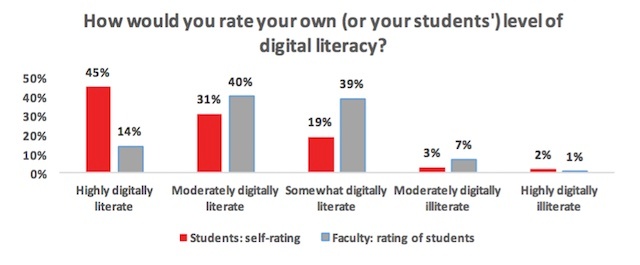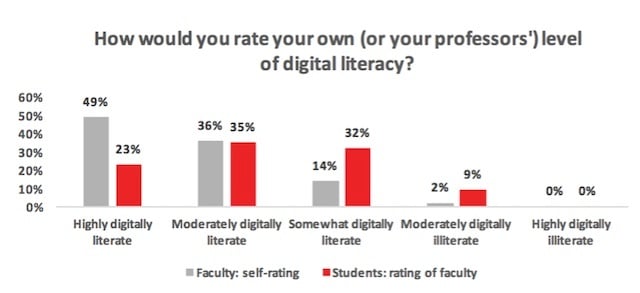The 2016 State of Digital Media in Higher Education
digital literacy competency vs. each other’s



Digital Literacy for St. Cloud State University



April 4, 2016 Christine Wolff, Alisa B. Rod, Roger C. Schonfeld http://sr.ithaka.org/?p=277685
The scholar-centric nature of the questionnaire ensures that potential changes in research and teaching inform our thinking, not only about academic libraries and scholarly publishing, but about changes in the educational enterprise more broadly.
My note:
By showcasing the diminishing role of physical presence and the increasing research using online methods, this study clearly proves that the 4/5 years debate if the reference librarians must sit on that desk (and answer the most popular question “where is the bathroom”) is futile.
What the study does not show, since it is conducted in its traditional (conservative) form, is that the library is NOT only the traditional library, where faculty and student search for information (being that in its physical appearance or in online access), but the library entails services, very close to the ones offered by IMS.
I see a discrepancy between literature (where libraries compel much more proactive approach regarding services) and the structure of this survey, which focuses on the traditional (conservative) role of the library as a gatekeeper to online resources [only]. Besides entrenching in 90’s practices of information literacy and/or “dressing up” old-fashioned information literacy with the new cloths of “digital literacy”as I witness at my workplace, the faculty must have been surveyed on the skills in metaliteacies, which the library can [must] provide, as per literature.
Does music help learn better? get smarter? advance in life?
keywords: music, education, intelligence.
Misra, S., & Shastri, I. (2015). Pairing Linguistic and Music Intelligence. International Journal Of Multidisciplinary Approach & Studies, 2(5), 32-36.
Costa-Giomi, E. (2015). The Long-Term Effects of Childhood Music Instruction on Intelligence and General Cognitive Abilities. Update: Applications Of Research In Music Education, 33(2), 20-26.
Juchniewicz, J. (2010). The Influence of Social Intelligence on Effective Music Teaching. Journal Of Research In Music Education, 58(3), 276-293.
Silvia, P. J., Thomas, K. S., Nusbaum, E. C., Beaty, R. E., & Hodges, D. A. (2016). How Does Music Training Predict Cognitive Abilities? A Bifactor Approach to Musical Expertise and Intelligence. Psychology Of Aesthetics, Creativity, And The Arts, doi:10.1037/aca0000058
Rickard, N. S., Bambrick, C. J., & Gill, A. (2012). Absence of Widespread Psychosocial and Cognitive Effects of School-Based Music Instruction in 10-13-Year-Old Students. International Journal Of Music Education, 30(1), 57-78.
Munsey, C. (2006). Music lessons may boost IQ and grades. American Psychological Association, 37(6), 13.
Schellenberg, E. G. (2011). Music lessons, emotional intelligence, and IQ. Music Perception, 29(2), 185-194. doi:10.1525/mp.2011.29.2.185
Kaviani, H., Mirbaha, H., Pournaseh, M., & Sagan, O. (2014). Can music lessons increase the performance of preschool children in IQ tests?. Cognitive Processing, 15(1), 77-84. doi:10.1007/s10339-013-0574-0
Degé, F., Kubicek, C., & Schwarzer, G. (2011). Music lessons and intelligence: A relation mediated by executive functions. Music Perception, 29(2), 195-201. doi:10.1525/mp.2011.29.2.195
Sharpe, N. N. (2014). The relationship between music instruction and academic achievement in mathematics. Dissertation Abstracts International Section A, 75.
keywords: music, education, multimedia.
Crappell, C., Jacklin, B., & Pratt, C. (2015). Using Multimedia To Enhance Lessons And Recitals. American Music Teacher, 64(6), 10-13.
le Roux, I., & Potgieter, H. M. (1998). A Multimedia Approach to Music Education in South Africa.
http://www.edtechmagazine.com/k12/article/2016/01/how-libraries-fit-future-learning
Amy Brown, M.Ed. is a K-12 education strategist for CDW·G. January 20, 2016
According to the New Media Consortium’s Horizon Report: 2015 K-12 Edition, schools all over the nation have begun promoting content creation over content consumption.
When evaluating equipment, administrators need to consider how it will work with the space.
More about school media places and the future for information media in academia:
https://blog.stcloudstate.edu/ims/?s=library&submit=Search
related IMS blog entry: https://blog.stcloudstate.edu/ims/2016/02/24/open-educational-resources/
http://www.freetech4teachers.com/2016/02/piclits-inspire-creative-stories.html
PicLits is a site for finding creative writing prompts. PicLits aims to provide inspiration for writing short stories. PicLits tries to reach this goal by providing users with images upon which they can build their writing.
More on effective ways to present your work in this blog: https://blog.stcloudstate.edu/ims/?s=effective+presentation&submit=Search
http://www.freetech4teachers.com/2015/10/7-good-sources-of-writing-prompts.html
Things to Think About
StoryToolz
Write About This
Make Beliefs Comix
Something to Write About
Toasted Cheese
Scholastic Story Starters
Apricot
More on digital storytelling in this IMS blog:
https://blog.stcloudstate.edu/ims/?s=digital+storytelling&submit=Search
Plan
———–
————————————
More on presentations in this IMS blog:
free image sources:
https://blog.stcloudstate.edu/ims/2014/06/01/social-media-and-presentations-free-image-sources/
Presentation tools for teachers:
https://blog.stcloudstate.edu/ims/2014/07/09/2014-best-educational-web-sites/
Basics of design:
https://blog.stcloudstate.edu/ims/2013/01/22/basics-of-design/
http://variety.com/2015/digital/news/netflix-better-streaming-quality-1201661116/
a new bandwidth-saving technology that the company has been working on for four years
At the lowest end was a file encoded with a bitrate of 235 kbps, which would work even on very slow connections, but also only deliver a resolution of 320 by 240 pixels. Somewhere in the middle was a 1750 kbps file for a resolution of 1280 by 720, and the best quality was a 5800 kbps version for a great-looking 1080p experience.
short link to this blog entry: http://scsu.mn/1P39zKV
short link to this blog entry: http://scsu.mn/1P38liN